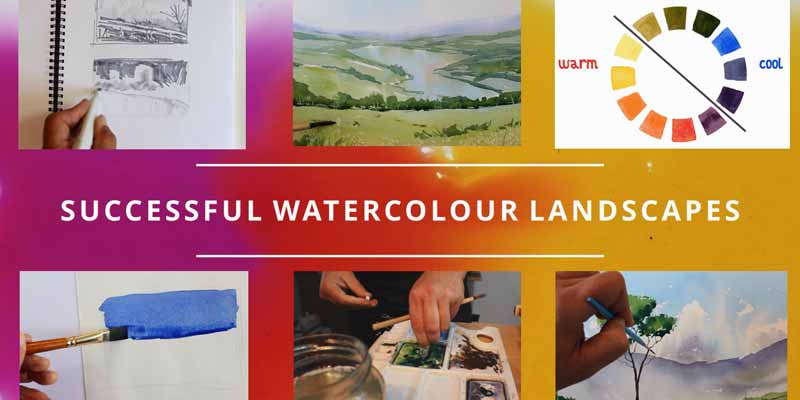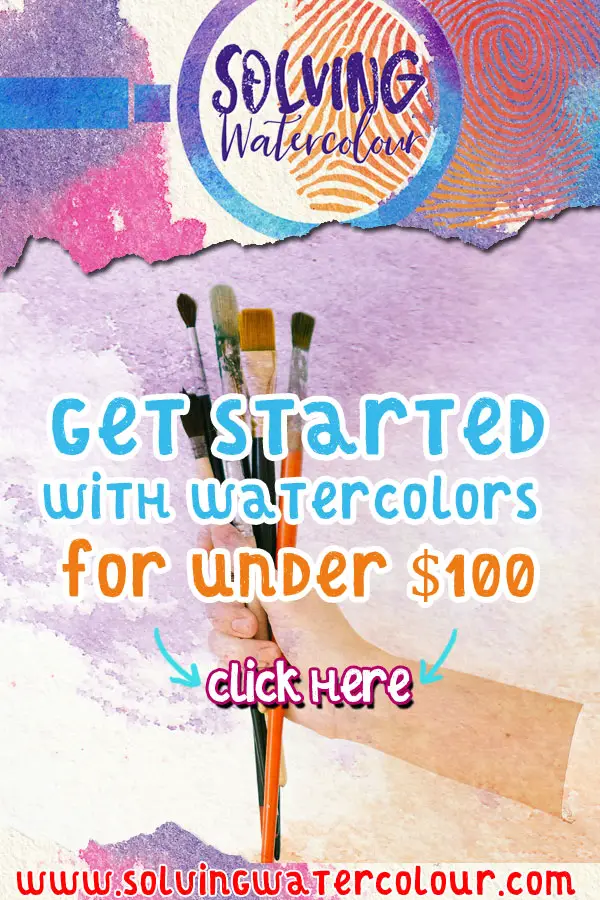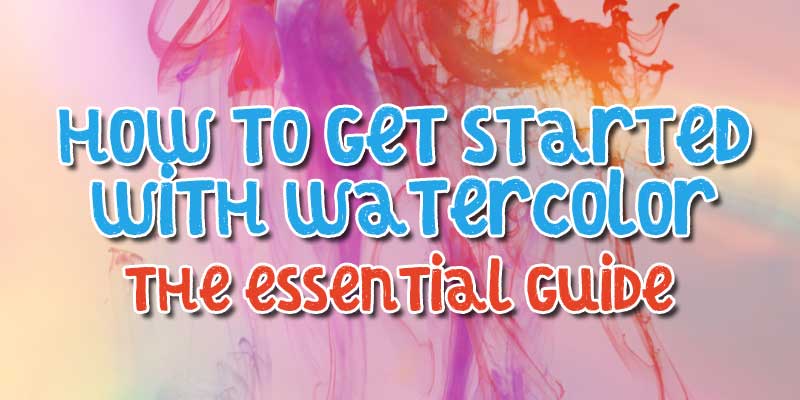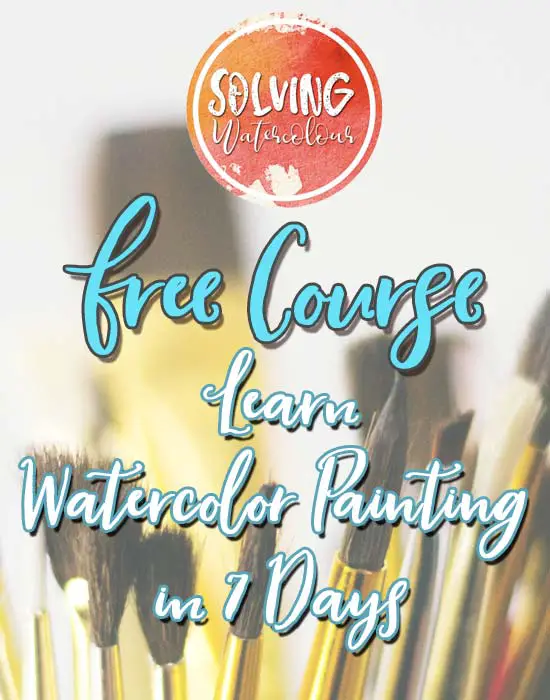- Can I Teach Myself To Paint Watercolors?
- Is It Hard To Learn Watercolor Painting?
- Which Is Easier, Watercolor, Oils or Acrylic?
- What Skills Do I Need To Get Good At Watercolor?
- How Long Does It Take To Get Good At Watercolor?
- What Equipment Do I Need To Start Painting Watercolor?
- Workspace
- Simple Watercolor Painting Techniques For Beginners
- Start Watercolor Painting For Less Than $100
Can I Teach Myself To Paint Watercolors?
There are so many resources that will teach you how to start watercolor painting in the comfort of your own home. There has probably never been a better time to learn even if attending a class is not possible for you. YouTube, of course, has a number of excellent watercolor channels and I have compiled a list of the best YouTube watercolor channels here.
If you are the kind of person who likes to learn from books, I also have a list of my favourite watercolor books for you to check out.
Udemy and Skillshare have many watercolor courses available for a reasonable price.
Good educational materials are essential of course but the next most important thing you will need to start watercolor painting at home, is to have a dedicated work space where you won’t be disturbed. It doesn’t need to be a spacious studio with an expensive easel. It could just be one end of your dining table with a desktop easel or even a lever arch file to rest your paper on. But having a dedicated area, without the need for clearing and reassembly every time you use it will make your chances of success that much higher.
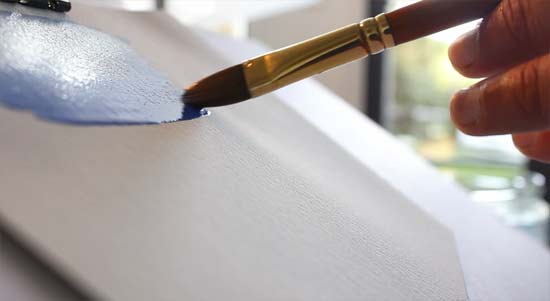
Allow yourself time to explore and experiment and don’t be too results focused at first. It’s only through a thorough understanding of your tools and materials and how they interact that you can get consistently good results.
Is It Hard To Learn Watercolor Painting?
Watercolor is often considered to be the most difficult medium to learn and it is true that realism can be quite difficult to achieve. Realism, though, is not necessarily the goal of every artist. There are, in fact, many watercolor techniques that are quite easy to learn and utilize. An example would be using watercolors as a wash over an ink drawing. Abstract and impressionistic watercolors can be very simple and fun to paint. See my abstract watercolor tutorials here and here. Have a go at these five easy watercolor painting ideas.
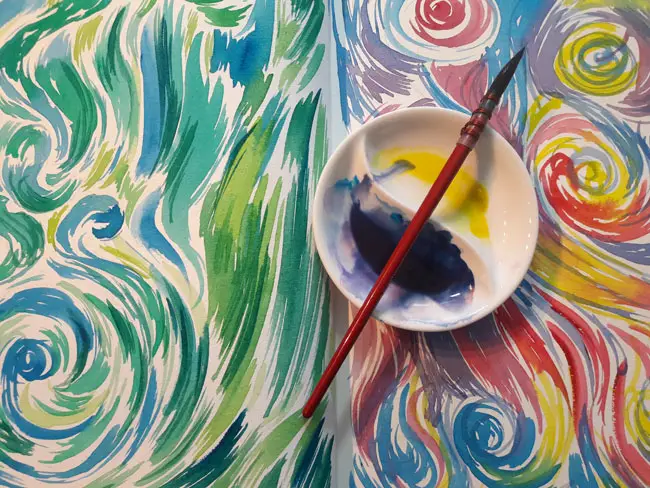
The main reasons why watercolors are considered to be difficult to learn are as follows.
- Watercolors are unforgiving, because their transparency makes it difficult, if not impossible to paint over mistakes.
- Watercolor is fast. The paint paint dries very quickly compared to other media and once it has dried, it can’t easily be blended or manipulated.
- Watercolor is unpredictable. The wet into wet painting technique can cause random blooms and back runs making it difficult to control. It requires a willingness to let go and allow it to do it’s own thing.
- Watercolor paper can be expensive and the price of materials can foster hesitancy and an unwillingness to experiment.
- Watercolor paintings often require advance planning in order to achieve a successful outcome. This may make it less appealing to those who prefer to take a more spontaneous approach to their artwork.
- Watercolors dry lighter than when first painted which can make it difficult to achieve the correct tonal values.
Which Is Easier, Watercolor, Oils or Acrylic?
Every painting medium has it’s own idiosyncrasies and watercolor is no exception. It is probably true to say that in general, watercolors are less intuitive to learn to paint with than other media. A counter-intuitive aspect of the watercolor painting process, is the necessity of always having start with the lightest tones and add progressively darker tones in a series of layers or “Glazes”. This is because the white of the paper has to be preserved rather than adding white paint later.

Compare this approach with other media that use opaque color. With oils and acrylics, you can begin by blocking in the largest shapes with a mid-tone and then go darker or lighter from there. I would contend that this approach is the most intuitive way to paint, allowing the artist the maximum opportunity to improvise. With oils and acrylics, you are able to paint over mistakes with lighter or darker colors. A successful watercolor may look spontaneous but it often requires a lot of pre-planning and rehearsal to get it right.
Acrylics and oils have disadvantages too of course. Acrylics dry very quickly and darken as they dry making it difficult to blend them smoothly. Oils can be messy and smelly requiring linseed oil and toxic thinners. They are very slow to dry and require a lot of preparation time.
What Skills Do I Need To Get Good At Watercolor?
There are a range of skills you need to master in order to become a competent artist in any medium. These all apply to watercolor too.
- Understanding the medium is the first requirement. Every painting medium has it’s own rules based on it’s physical properties that determines how to get the best results from the medium. The main property of watercolor that sets it apart from other paint media is it’s transparency. This, in turn determines the order in which you have to lay the paint down as you cannot paint light over dark. Controlling the flow of paint when painting wet into wet is an important skill to learn , and knowing how much water is present on your brush and paper and how it will affect your painting. You will need to learn how to paint flat washes evenly, and how to build up layers of transparent colors i.e glazing.
- Drawing. Drawing skills are the foundations on which everything else is based. Your painting skills will only ever be as good as your drawing skills are.
- Color Theory. Understanding colors and the rules of how to mix them and match them will enable you to create mood and emotion in your paintings and knowing the rules enables you to innovate and break them when required.
- Design. Design is like the glue that holds everything together. Design is all about how you organize the elements of your painting for the most pleasing aesthetic result. Design is mainly about composition but also includes use of color and tonal value to create balanced compelling paintings.
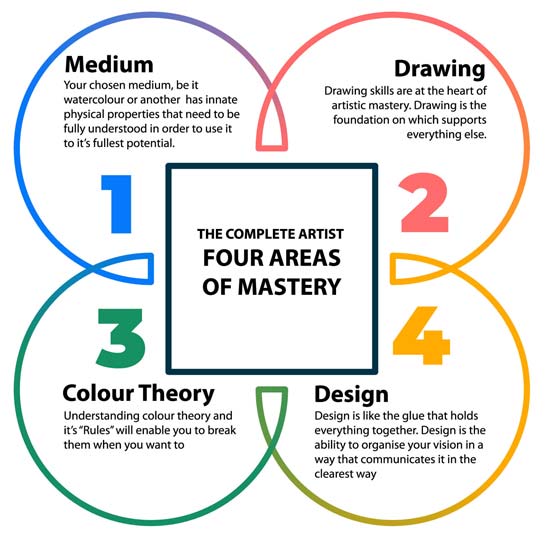
How Long Does It Take To Get Good At Watercolor?
Everybody has heard the theory that it takes 10,000 hours of practice to master a skill but this is a huge generalization that assumes you are starting completely from scratch. In practice everybody learn at different speeds and the level of your existing artistic skills will dramatically affect the length of time it takes you to get good at watercolor. If you have good drawing skills, solid color theory knowledge and design skills then it may only take a tenth of the time to learn watercolor than someone who has to learn those things as well.
You can give yourself a head start by beginning with the right equipment and supplies. I’ve often said that it took me much longer to learn than it should have because I was using cheap watercolor paper that was not up to the job.
What Equipment Do I Need To Start Painting Watercolor?
Paint
Let’s with the most obvious item. Paint. The first thing you need to know is that all watercolor paints are not created equal. Really cheap watercolor paints (The you can buy in a dollar store ) are not really watercolors at all. They are difficult to work with and are usually pale, insipid and chalky when dry. Don’t waste your time with these.
Genuine watercolor paint is usually either Student or Artist grade and contains a mixture of raw pigment mixed with binders such as Gum Arabic, honey (Which aids with re wetting), Ox Gall ( A dispersant which aids the flow of the paint) and fillers such as Dextrin (Bulks out the paint without affecting the color too much). The expensive Artists quality paints contain a higher ratio of expensive pigments to the student grade paints which will tend to have more filler. Artist grade paints should be more vibrant and lightfast than their student grade counterparts.
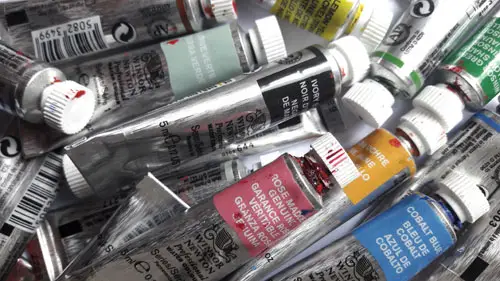
Student and beginner brands include Reeves, Cotman (Made by Winsor and Newton), Grumbacher.
Artists quality Brands include. Winsor & Newton, Daniel Smith, Schminke, Sennelier
Paint quality doesn’t have to be an either, or decision. I personally use a mixture of Cotman student grade paints and Winsor and Newton Artist grade paints.
Amazon has an introductory set of Daniel Smith watercolor tubes or this set of ten 8ml tubes from Cotman are a very reasonable price. I would recommend either of these for those just looking to get started.
Should I Use Watercolor Pans or Tubes?
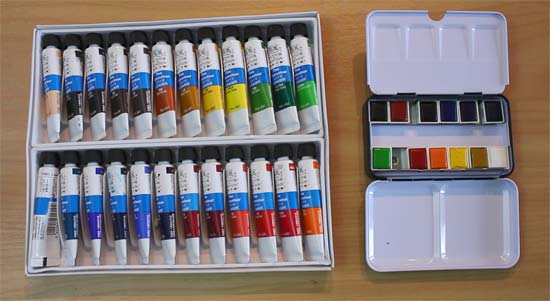
Pans are great for working outdoors and for quick sketches with a small to medium sized brush but they’re not conducive to working at larger sizes. So I would generally recommend using tubes where possible, but my recommendation for pans would be this Winsor & Newton metal professional sketcher’s box set very similar to the one I have, or this great value budget option of the Cotman 45 half pan studio set.
Another option which would give you the best of both worlds would be to buy a basic tin of empty half pans like this one and fill them yourself with tube colors.
How Many Colors Do I Need?
This subject really merits an entire post. But to put it briefly. There is no need to go out and buy every color under the sun in the possibility that you might use it someday. Remember, that you can mix any color from the three primaries Red, Yellow and Blue, but to make life easier, it doesn’t hurt to include a few earth colors in there such as raw sienna and burnt sienna and I find that having a cool neutral such as Paynes Grey to be very handy.
The advantage of limiting your palette like this, that your paintings will naturally tend to be more unified and you will get the experience of learning how to mix. Limiting your palette reduces the choice overload that you will experience by having too many options.
Basic 7 Color Watercolor Palette For Beginners
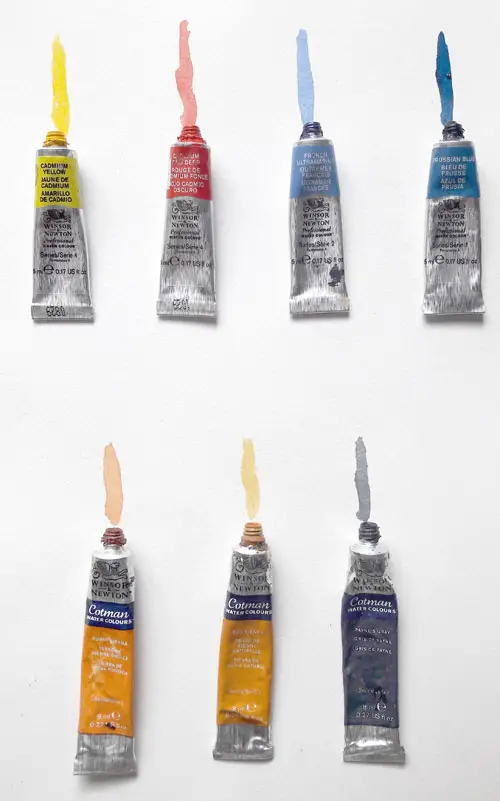
French Ultramarine, Prussian Blue, Alizarin Crimson and, or Cadmium Red, Cadmium Yellow, Paynes Grey, Raw Sienna, Burnt Sienna.
Below is my recommendation for a slightly expanded palette which should cover most situations. It consists of a good range of primaries ( Blue, red and yellow), some earth colors and a neutral.
Cerulean Blue: Winsor & Newton | Daniel Smith
Ultramarine Blue: Winsor & Newton | Daniel Smith
Prussian Blue: Winsor & Newton |Daniel Smith
Lemon Yellow: Winsor & Newton | Daniel Smith
Cadmium Yellow: Winsor & Newton |Daniel Smith
Raw Sienna: Winsor & Newton | Daniel Smith
Cadmiun Red: Winsor & Newton | Daniel Smith
Alizarin Crimson: Winsor & Newton | Daniel Smith
Burnt Sienna: Winsor & Newton | Daniel Smith
Burnt Umber: Winsor & Newton | Daniel Smith
Paynes Gray: Winsor & Newton | Daniel Smith
You’ll notice that I haven’t included any greens in that list. This is because I prefer to mix my own greens. I find that personally, most of the available pre-mixed greens are not suitable for my landscape painting . For more info about this and a downloadable color chart.

Water
Let’s not forget that you will of course need water to paint with watercolor. It sounds obvious but It’s important to have a big container of clean water on hand at all times. I use lots of different things for water containers, Pickle Jars, yoghurt containers It really doesn’t matter. Some artists like to have two jars of water on their desk, one to clean their brushes with and one to dilute their paints with so that your colors do not become contaminated with dirty water. The problem is remembering which one to use, as the brush cleaning water will tend to get dirty very quickly. I prefer to keep a jar of water to clean my brushes and a small spray bottle to dilute my paint with.
You can also spray the water directly on to the paper before you paint or after, to soften hard edges for instance, or to keep areas wet that are drying out too quickly. You can put dilute paint into the bottle and spray it directly on to the paper to create some great effects.
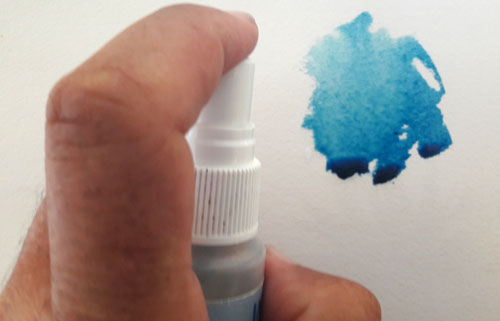
I have found that a small spray misting bottle is indispensable for watercolor painting. As I’ve already mentioned, it’s perfect for diluting and rewetting paint on the palette as there is no risk of contaminating your colors as the water inside the spray bottle is always going to be clean.
Paper
The quality of the watercolor paper you use is probably more important than the quality of the paint you use. That may seem hard to believe at first but speaking as someone who wasted a lot of time painting on poor quality paper with good quality paints, I can assure you that this is true. Poor quality paper will completely cancel out any gains that you get from using good quality paints.
The best quality watercolor papers are handmade 100% cotton paper can be hot or cold pressed hot pressed is very smooth texture and is often used in botanical illustration. Most watercolor artists use cold pressed paper which has more texture than hot pressed but not as much as “Rough” paper.
Palette
In order to mix colors, you will need a palette. These can be incredibly cheap plastic palettes like this which are perfectly adequate, or a more upmarket porcelain version. Many artists use large plastic butcher’s trays in order to accommodate larger brushes and big pools of paint. The most important feature of a palette is that it is pure white and has depressions large enough to contain enough paint for your needs. Successful watercolor relies on speed of execution so it’s not practical to be continually mixing up tiny batches of color.
I certainly recommend using a porcelain palette. Paint mixes beautifully, without forming into streaky patches as often happens with plastic. You don’t have to spend a fortune. I have a couple of white plates that I bought for a couple of dollars from a second hand store, that work perfectly for this purpose.
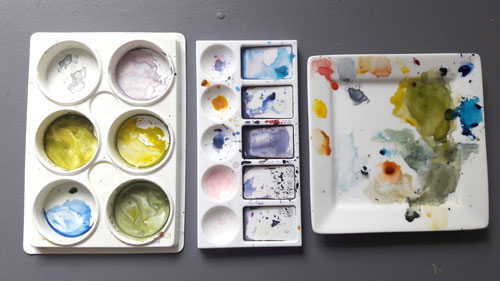
Brushes
For an in depth look at brushes and their various forms and uses please check out this blog post.
Again. There is no need to spend a fortune on brushes. If you can only afford to buy one brush, get a medium sized round brush as this will give you the most bang for your buck and enable you to make the widest range of strokes . When choosing a round brush it’s important to get a good quality one. Choose a quality brand such as Winsor & Newton, Raphael, Escoda and Da Vinci to name a few. The main thing to look for is a brush that forms and can maintain a good point even after repeated use.
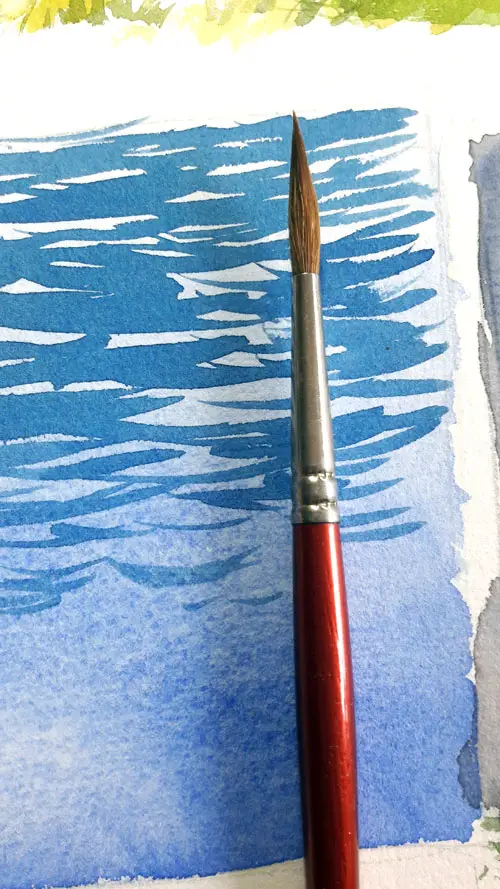
The most expensive brushes are made of Kolinsky Sable but a good quality synthetic such as Prolene will serve you well, although the properties of synthetic hair are somewhat different to sable. Sable being less springy. It’s partly about what you get used to painting with.
I would recommend getting a medium sized round brush for general use a flat brush for making sharp angular strokes and a bamboo brush for loose rough strokes (e.g foliage and rock textures).
Da Vinci Brush, Round Size 2. Buy from Amazon
Mimik synthetic 3/4″ flat brush Buy from Amazon
Winsor & Newton No.6 Bamboo Brush Buy from Amazon
Watercolor Easels
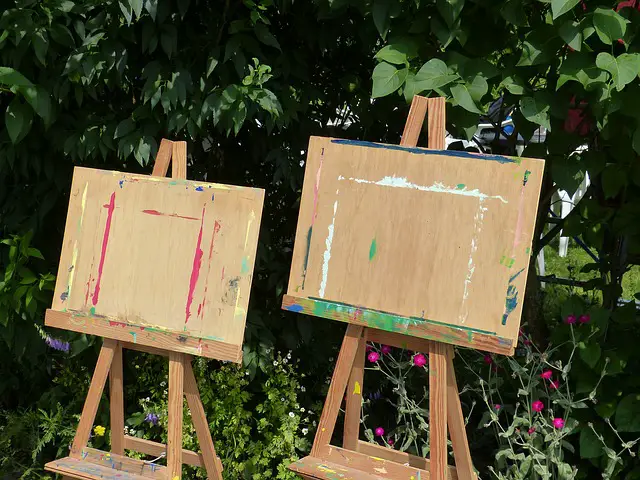
You can paint watercolors on a flat surface but angling the paper is an important part of controlling the flow of paint on the paper. For more on this, see my post on how to paint flat washes.
You don’t need an easel necessarily but some kind of angled drawing surface to paint on is essential. I started out using a small sheet of plywood resting on a lever arch file to angle it to about 25 degrees.
I now have a desktop easel like this one which doubles as an art supplies box. The beauty of this is that you can set it up anywhere. It’s perfect for any artist who has limited space to work.
For painting plein air, you’ll need a more traditional style of easel something like this Meeden French style sketchbox easel.
Storage / Carrying Case
You will need something to store your art materials in and honestly any box will do, though it helps if it has a latch of some kind, although a decent sized tin with a lid that can be put on tightly is absolutely fine.
I’d been toying with the idea of taking up watercolor painting seriously and finding this lovely wooden carrying case in a thrift store for $5 was like getting a gift of encouragement from the universe.

Workspace
Last but definitely not least you will need a studio or workspace of some kind. Not everyone is lucky enough to have a dedicated studio space. I have a home office which can double as a studio. Electronics and water don’t play well together and it’s often just easier to use the dining room table. Wherever your workspace is. It needs to be a space that you easily keep clean and free of clutter. Somewhere that you won’t constantly be disturbed. That might just mean having to wait until the kids are asleep or getting up extra early.
If you need some help trying to select appropriate art supplies for your needs I’ve put together a list of my recommended art supplies.
Simple Watercolor Painting Techniques For Beginners
Be sure to check out my post 24 Essential Watercolor Techniques for a more detailed overview of all the most important watercolor techniques that you need to know. But if you just want to get started with some simple painting ideas and basic painting techniques. Take a look at these video from my Youtube channel.
Video 1: Simple Watercolor Butterflies
In this video I demonstrate how to paint these simple butterfly inspired designs which use very basic watercolor techniques such as the Flat wash, glazing and wet into wet.
Video 2: Simple Watercolor Flowers
In this video I paint some very easy abstract flowers completely wet in to wet. With a little bit of practice, you’ll be able to produce these too.
Start Watercolor Painting For Less Than $100
As a beginner watercolor artist you don’t need to buy the the best of everything immediately. I would recommend buying the best quality paper you can afford but start with student grade paints. Many of the brushes I use cost less than ten dollars, so you definitely don’t need to go out and buy expensive Sable brushes.
I like to have at least one or two good quality round brushes that will maintain a good point, a large and a small flat brush that will keep their shape without splitting and fanning out and a cheap natural haired brush like a Hake or a bamboo brush. This covers all the bases for me. Princeton make good quality synthetic haired brushes for a reasonable price and the four piece set that I’ve linked to below are my choice for quality and value for money.
Cotman is Winsor & Newton’s student grade range of paints. I often use them alongside select tubes of Professional quality. While the difference in color intensity is noticeable in a side by side comparison, it’s not a massive one. Baohong watercolor paper is a recent discovery. It’s an excellent quality Chinese 100% cotton paper that is comparable to a professional quality paper such as Arches but is significantly cheaper.

Winsor & Newton Cotman Water Colour Paint Palette Set, Set of 10, 8ml Tubes
BAOHONG Artists’ Watercolor Paper Block
Princeton Velvetouch Series Set of 4 Brushes
Lucky Crown US Art Adjustable Wood Desk Table Light Weight, Easel
DerBlue 3Pcs Plastic Paint Tray Palettes
If you have a bit more to spend you might consider upgrading to a porcelain palette such as this one MEEDEN Artist Porcelain Watercolor Paint Palette as plastic palettes will stain over time making it more difficult to gauge your color mixes correctly.
Good luck getting started on your watercolor journey and if you’re interested in landscape painting don’t forget to check out my course Successful Watercolour Landscapes.
